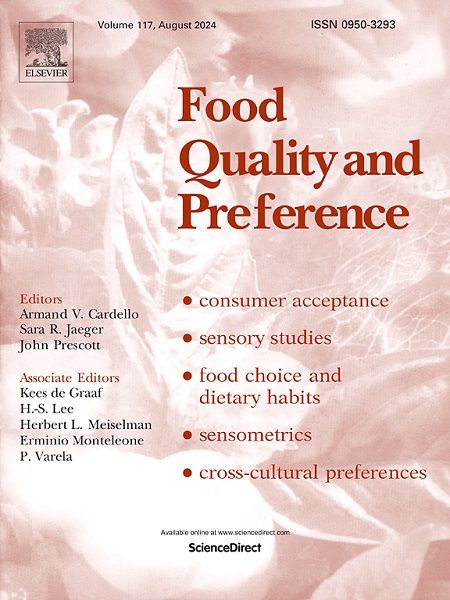The role of chewing efficiency in aroma release and perception during oral processing of solid model foods
IF 4.9
1区 农林科学
Q1 FOOD SCIENCE & TECHNOLOGY
引用次数: 0
Abstract
This study investigates the oral processing mechanisms underlying aroma release and perception during the chewing of solid model food particles (made from dental impression materials) in individuals with different chewing efficiency. By comparing the dynamic processes of model food particle breakdown, salivary secretion, protein concentration, and aroma release, it was found that individuals with higher chewing efficiency (‘high CE’ group) exhibited higher aroma release, with increased and longer perceived intensity. Increased chewing cycles were found to promote aroma release. However, this relationship varied between participants different chewing efficiency (‘high CE’ group vs. ‘low CE’ group), reflecting the underlying differences in their oral physiology (including model food mechanical breakdown, saliva secretion upon stimulation, and total salivary protein content during chewing). The hydrophobicity of aroma compounds (ethyl acetate vs. ethyl octanoate) undoubtedly affected both aroma release and perception during mastication. Unlike existing static headspace analysis studies, associations found from this study resulted from the multiple interplay of hydrogen bonds/hydrophobic interactions between aroma compounds and saliva proteins, mastication-induced saliva dilution effects, and the available release surface area due to chewing efficiency. Findings from this study provide novel insights into how individual differences in oral physiology and chewing efficiency—independent of the complex interactions between saliva and food matrices—impact aroma perception, and offer important implications for personalized food formulation and sensory perception optimization, particularly for populations with impaired oral processing abilities.
在固体模型食物的口腔加工过程中,咀嚼效率在香气释放和感知中的作用
本研究探讨了不同咀嚼效率个体咀嚼固体模型食物颗粒(由牙印材料制成)时香气释放和感知的口腔加工机制。通过比较模型食物颗粒分解、唾液分泌、蛋白质浓度和香气释放的动态过程,发现咀嚼效率越高的个体(“高CE”组)香气释放越高,感知强度越高,时间越长。增加咀嚼周期可以促进香气的释放。然而,这种关系在不同咀嚼效率的参与者之间有所不同(“高CE”组与“低CE”组),反映了他们口腔生理学的潜在差异(包括模型食物机械分解、刺激时唾液分泌和咀嚼时唾液总蛋白含量)。香气化合物(乙酸乙酯和辛酸乙酯)的疏水性无疑会影响咀嚼过程中香气的释放和感知。与现有的静态顶空分析研究不同,本研究发现的关联源于芳香化合物与唾液蛋白之间的氢键/疏水相互作用的多重相互作用、咀嚼诱导的唾液稀释效应以及咀嚼效率导致的可用释放表面积。本研究的发现为口腔生理和咀嚼效率的个体差异(独立于唾液和食物基质之间的复杂相互作用)如何影响香气感知提供了新的见解,并为个性化食品配方和感官感知优化提供了重要启示,特别是对于口腔处理能力受损的人群。
本文章由计算机程序翻译,如有差异,请以英文原文为准。
求助全文
约1分钟内获得全文
求助全文
来源期刊

Food Quality and Preference
工程技术-食品科技
CiteScore
10.40
自引率
15.10%
发文量
263
审稿时长
38 days
期刊介绍:
Food Quality and Preference is a journal devoted to sensory, consumer and behavioural research in food and non-food products. It publishes original research, critical reviews, and short communications in sensory and consumer science, and sensometrics. In addition, the journal publishes special invited issues on important timely topics and from relevant conferences. These are aimed at bridging the gap between research and application, bringing together authors and readers in consumer and market research, sensory science, sensometrics and sensory evaluation, nutrition and food choice, as well as food research, product development and sensory quality assurance. Submissions to Food Quality and Preference are limited to papers that include some form of human measurement; papers that are limited to physical/chemical measures or the routine application of sensory, consumer or econometric analysis will not be considered unless they specifically make a novel scientific contribution in line with the journal''s coverage as outlined below.
 求助内容:
求助内容: 应助结果提醒方式:
应助结果提醒方式:


